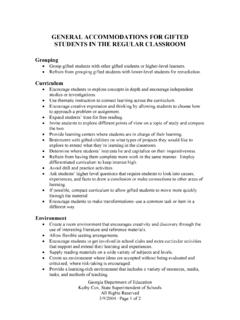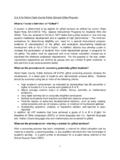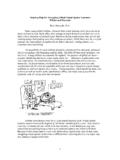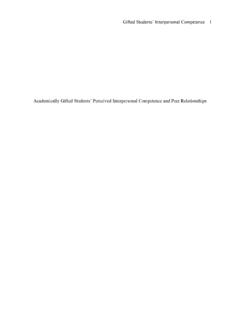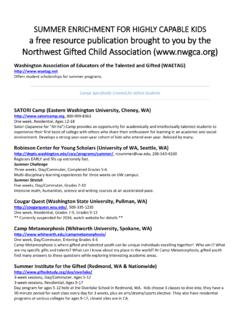Transcription of The Workplace Mobbing of Highly Gifted Adults: …
1 Reuven Kotleras Vo lume 11, 2007 130 The Workplace Mobbing of Highly Gifted adults : an unremarked barbarism Reuven Kotleras Reuven Kotleras, an extraordinarily Gifted exCchild and internationally known writer whose published, peerCreviewed work ranges from European political history and presentCday Asian economic development to the epistemology of scientific inquiry and aspects of mathematical logic, is also a consultant in human informationCprocessing,decision analysis, and organizational design. ABSTRACT: Workplace Mobbing leads to severe health consequences, both physical and psychological. It can result in the destruction of an individual s personality and his effective expulsion from the labor force. The distinctive traits of Highly Gifted adults put them at increased risk of Workplace Mobbing .
2 These traits may include their difference from others and others misunderstanding of that difference, a distinct moral sense, drivenness and strength of feeling, perfectionism and estheticism, overwhelming perceptiveness, overwhelming multifacetedness, and the need for solitude and search for meaning. Paradoxically, however, the sensitivities and overexcitabilities of Highly Gifted adults may diminish their ability to interpret and confront the experience of being mobbed. Highly Gifted adults who have been mobbed in the Workplace may require differential therapeutic intervention, for the same reason that Gifted children who are tormented by schoolyard bullies do. THIS ARTICLE IS DEDICATED TO CANDICE LLOYD. The Ephesians would do well to hang themselves, every grown person of them, and leave the city to beardless lads; for they have cast out Hermodorus, the best person among them, saying, We will have none who is best among us; if there be any such, let him be so elsewhere and among others.
3 Heraclitus The purpose of this article is to draw attention to an issue that appears to be unrecognized in studies of Highly Gifted ex1children. The The Workplace Mobbing of Highly Gifted adults 131 Advanced Development Journal issue is Mobbing , a phenomenon of psychological terror .. in working life [that] involves hostile and unethical communication, which is directed in a systematic way by one or a few individuals mainly towards one individual who is pushed into a helpless and defenseless position, being held there by means of continuing Mobbing activities (Leymann, 1996, p. 168). Only relatively recently have researchers and therapeutic workers given attention to the Workplace Mobbing of adults in general. I wish to offer the proposition that Highly Gifted exCchildren are likely to suffer Mobbing in the Workplace out of proportion to their presence in the general workforce.
4 Whether or not empirical study validates this proposition, I further assert that Highly Gifted exCchildren who suffer Mobbing in the Workplace may require differential therapeutic intervention, for the same reason that Gifted children who are tormented by bullies do. Mobbing or Bullying ? Research on Mobbing has so far been most advanced in Scandinavia, Germany, and Austria. The phenomenon is rather less well recognized in the United States (but see Davenport, Schwartz & Elliot, 2005). Although the term bullying (sometimes Workplace bullying ) is used in Australia and the United Kingdom, in fact bullying and Mobbing are behaviorally distinct and analytically different. Bullying is defined by the behavior of the instigator, Mobbing by its effects on the target. Leymann s path1breaking studies of Mobbing arose from the context and discipline of industrial psychology, focusing on such questions as how intense Mobbing had to be to produce psychological stress or psychosomatic illness.
5 This disciplinary background and focus also distinguish the study of Mobbing from that of bullying. Still more important, Mobbing is a work conflict in which one person [is] singled out, harassed, and ostracized over a long period of time, .. not a short episode but a long1lasting wearing1down process, often lasting much longer than one year (Zapf & Einarsen, 2005, pp. 243, 248; compare Leymann, 1996, p. 167). The systematic and long1term nature of the aggression effectively distinguishes Mobbing from normal interpersonal conflict. Leymann and Gustafsson (1996, p. 273) explain how Mobbing victims find their trauma constantly renewed as new sources of anxiety occur in a constant stream while continuing violations of the individual s rights further undermine his or her self1confidence and psychological health.
6 Reuven Kotleras Volume 11, 2007 132 Also, Mobbing .. often refers to subtle, less direct forms of aggression as opposed to the more physical forms of aggression commonly identified with bullying (Zapf & Einarsen, 2005). Its key elements include powerlessness, power differences, and loss of control, ( ) which are absent from the other concepts of Workplace of interpersonal conflict. It is, rather, characterized by severe and Highly interpersonal conflict in which a power difference exists between the parties, indeed by an almost complete lack, on the part of the target, of such resources as energy, coping strategies, control, and social support (Zapf & Einarsen, 2005, pp. 261, 238, 255). For purposes of case reporting, Leymann (1996) defined Mobbing as a social interaction through which one individual (seldom more) is attacked by one or more (seldom more than four) individuals almost on a daily basis and for periods of many months, bringing the person into an almost helpless position with potentially high risk of expulsion (p.)
7 168). In fact, it is often the case that the mob is more than four. Westhues (2002) better captures the tenor of Mobbing by describing it as an impassioned, collective campaign by co1workers to exclude, punish, and humiliate a targeted worker, .. a desperate urge to crush and eliminate the target [that] travels through the Workplace like a virus, infecting one person after another (pp. 31132). A classic example of such behavior was depicted in Alfred Hitchcock s film The Birds. The sense of psychological terror from unrelenting assault on all sides portrayed in Tippi Hedren s character as the birds batter through the cabin walls and exhaust her through the incessant sharp onslaught tearing her skin and attacking her eyes is not at all far from the experience of Mobbing targets as they are repeatedly over time attacked in the Workplace by their swarming colleagues.
8 In fact, the term translated into English as Mobbing originated in ethology, with the study of bird behavior. Westhues (2007) remarks that Lorenz s original German term was the one used in old German hunting language for collective attack by birds: hassen auf, which means to hate after or to put a hate on [and] .. emphasizes the depth of antipathy with which the attack is made, .. an important connotation that the English word lacks. How severe is Mobbing ? Mobbing leads to such severe health consequences that even health professionals such as physicians and psychologists may not believe that the health damages they observed could be due to conditions in the Workplace (Zapf & Einarsen, 2005, p. 243, emphasis added). Leymann discovered in the early 1990s that persons who have been mobbed may in their reactions be compared with those accounted for in a Norwegian study concerning raped The Workplace Mobbing of Highly Gifted adults 133 Advanced Development Journal women, , that post1traumatic stress disorder (PTSD) is probably the correct psychiatric and psychological diagnosis for approximately 95% of the subjected individuals (Leymann & Gustafsson, 1996, pp.)
9 272, 252). Between 10% and 20% of annual suicides in Sweden have Mobbing processes at work in the background (Leymann, 1996, p. 173). Having overcome the trauma of a series of physical assaults culminating in a near1rape during late childhood, and then decades later been mobbed in professional life, I can affirm experientially that Mobbing develops a destructive power that can equal the severe forms of physical violence or sexual harassment (Zapf & Einarsen, 2005, p. 262). Examples of Mobbing Behavior Leymann (1996) intuited that Mobbing behaviors might vary from culture to culture. My experience bears this out. It was constructed within an institution where the particular cultural characteristics of its own social and political milieu were intensified. I was almost totally socially shunned from the start simply because I did not belong.
10 Even before any Mobbing started, some colleagues passing me in the hall would avert their eyes, casting them downward in the direction opposite to my approach. In over five years no colleague ever invited me to his or her home, and I can count the invitations to restaurants, bars, or just coffee on one hand and still have a few fingers left over. In this social vacuum, the Mobbing was very Highly administratively organized, which style also expressed the social culture of the organization where I worked. This I can describe only by synthesizing, from out of Weber s sociological work, the category of bureaucratized sultanism (compare Parsons, 1947, p. 62; Weber, 1946, p. 442). By this I designate an exaggerated deference at all levels to an institutional authority that has inherited or assumed the aura of sacral law, where the only restraint upon a bureaucrat s full arbitrariness is his anticipation of the arbitrariness countervailed by administrative superiors.
